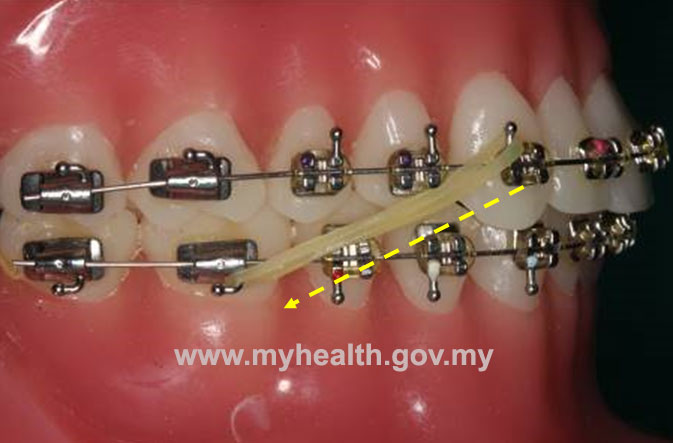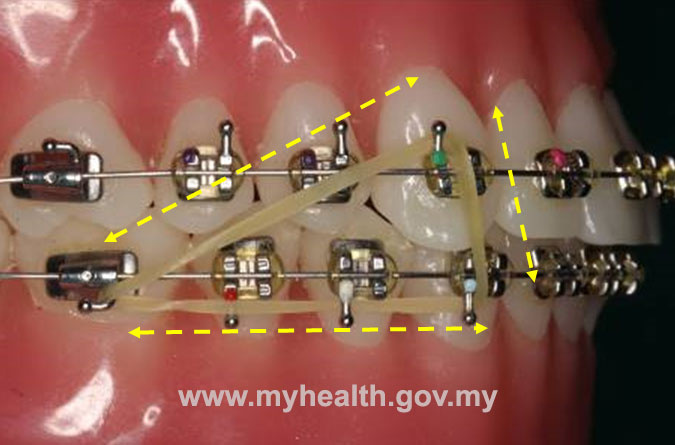What Is It?
An elastic (rubber band) is essentially a small rubber band that your orthodontist will tell you to attach to your braces in a certain configuration/shape. The purpose of the elastic is to allow the patient to assist the orthodontist in the movement of their teeth. Braces sometimes may not be able to move teeth exactly where the orthodontist would like, thus elastic wear can help to achieve this movement.
These elastics are crafted from the medical-grade latex, which is safe to be in contact with your mouth. Non-latex elastics are also available for patients who are allergic to latex.
What Do Elastics Do?
While brackets, archwires and ligatures are responsible for moving teeth along the gumline and at the angle at which they point away from the gums, rubber bands pull the dentition forward or backward in order to line up your top and bottom rows of teeth to improve your smile and make your teeth fit together comfortably when you bite down. They are often used to help close spaces, or make sure spaces are closing in the right direction, and improve midlines (middle points of the rows of teeth). They can also be used to assist the process of moving or straightening a tooth or teeth.
How To Wear The Elastic?
Brackets with hooks are placed along the side of the mouth one or more on both left and right side of the top and bottom set of teeth. An elastic is attached on each side of the mouth- from one hook / bracket to the other. The angle of an elastic depends on how much pressure needs to be applied to fix the overjet (upper teeth jutting out) or reverse overjet (lower teeth jutting out). The elastic is generally classified by the problem that is to be corrected. Illustrations of different ways elastics can be worn are shown below.
Configuration of Elastics
Class 1 Elastics (to close gaps)
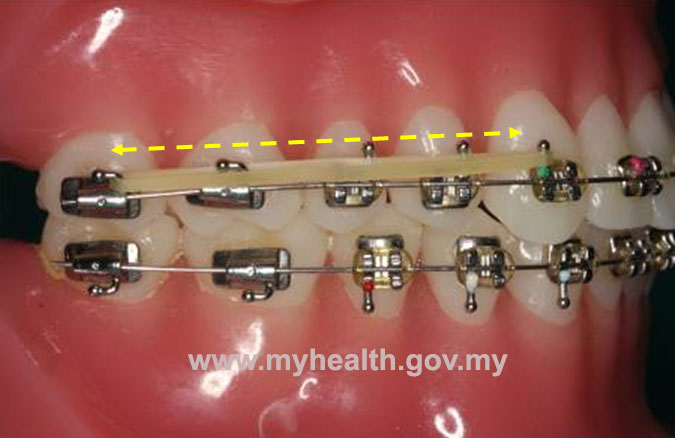
These elastics run from the upper first or second molar hook to the upper canine hook. These push teeth together to help close any gaps between the teeth. It can be also used on the bottom teeth.
Class II Elastics (to correct an overjet)
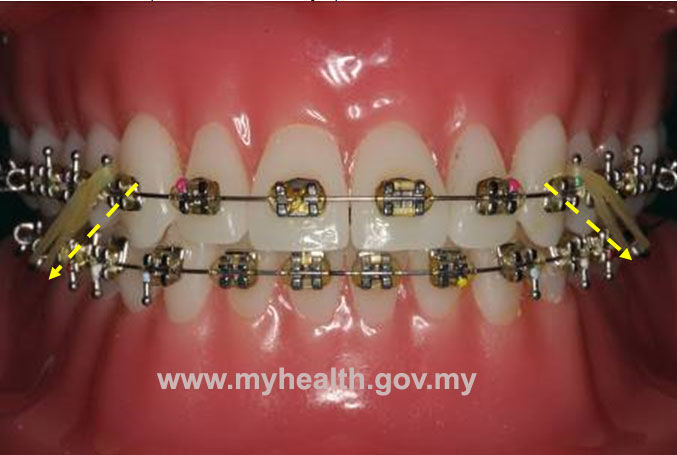
These elastic usually attach from the upper canine hook to either the bottom 1st molar hook or 2nd molar hook. These elastics help move your upper teeth back and your bottom teeth forward.
Like the Class II elastic, this elastic starts from the upper canine hook. It also attaches to a bottom bicuspid (premolar) hook along with the bottom 1st molar or 2nd molar hook forming a triangle. This helps move your upper teeth back and bottom teeth forward and also helps bring the back teeth together and touching.
Class III Elastics (to correct an reverse overjet or lower teeth prominence)

The elastic starts from the bottom canine and goes to the upper first or second molar. This moves the upper teeth forwards and bottom teeth back.
Anterior triangle elastics (to keep teeth together)
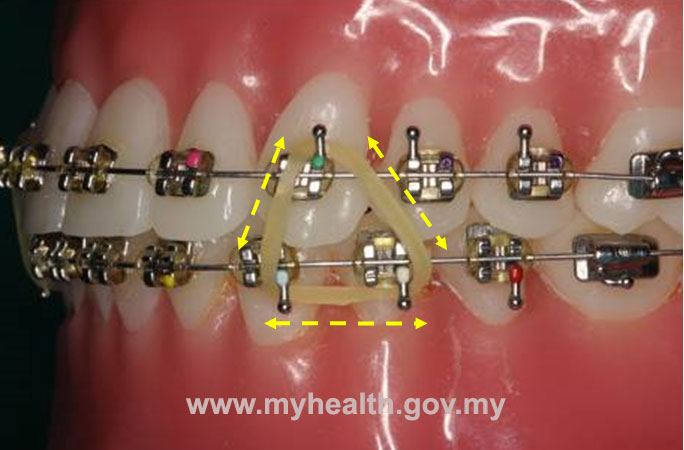
These elastics usually run from the upper canine hook to the bottom canine and first premolar hooks forming the shape of triangle. This elastic helps improve in open bite situation where your top front teeth do not touch the bottom front teeth.
V Elastics (to bring teeth together)
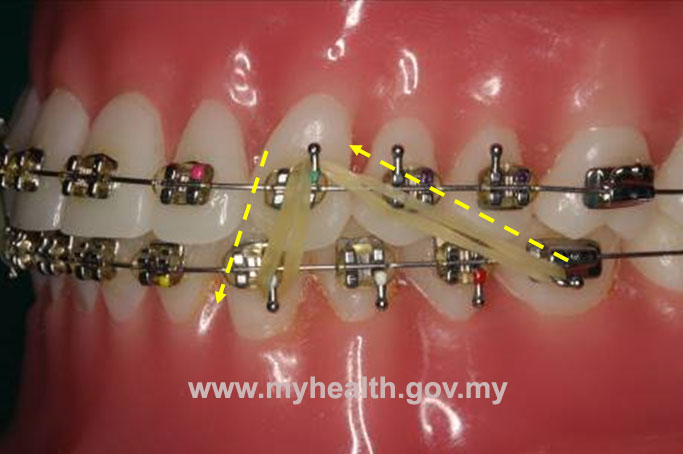
These elastics attached to three teeth and form the shape of a V. These elastics help bring teeth together and touching. They can be used on the front teeth or back teeth.
Front Cross Elastic (to correct a midline)
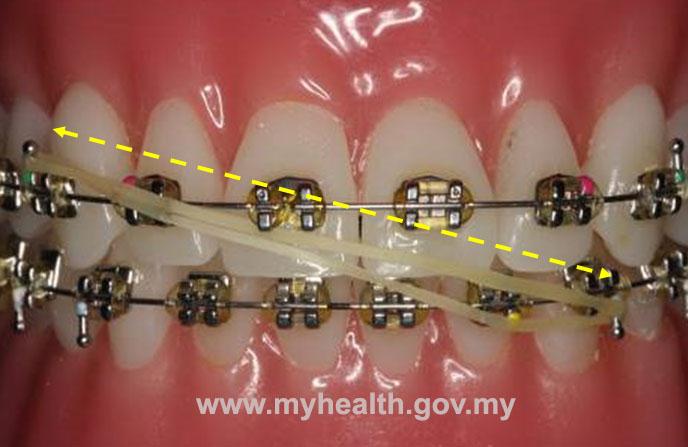
Midline elastic- this elastic run from the upper canine hook to the bottom canine hook but can also be attached to other front teeth. The elastic helps line up the center of the upper and bottom front teeth.
Anterior Box Elastic (to bring teeth together)
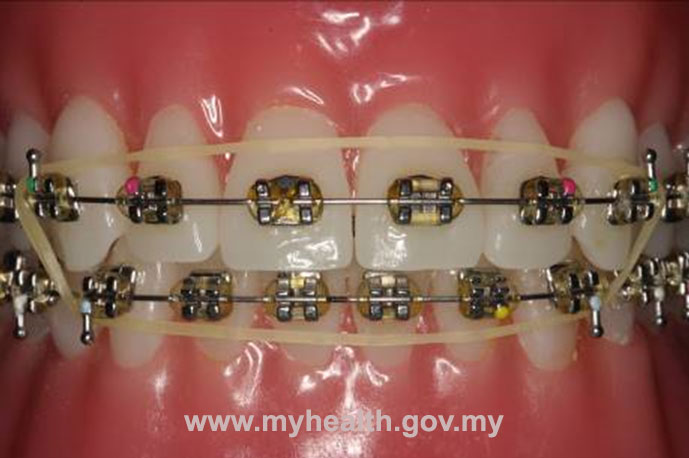
The elastic is attached to four teeth; two on the upper and two on the bottom forming the shape of the box. This helps to bring the upper and lower front teeth together and touching.
The elastic is attached to four teeth; two on the upper and two on the bottom forming the shape of the box. This helps to bring the upper and lower back (cheek) teeth together and touching.
Crossbite Elastic (to correct a crossbite)
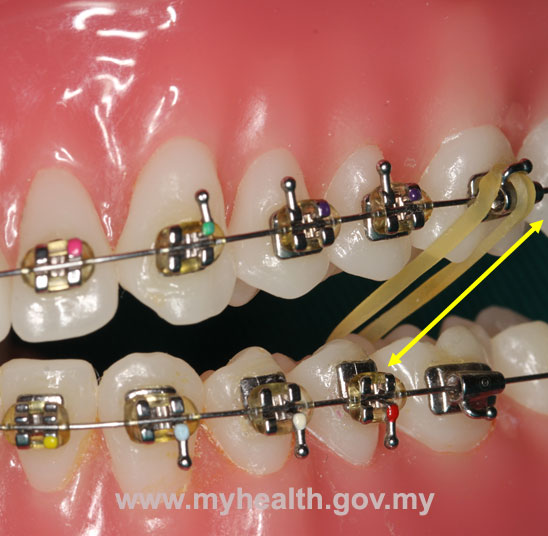
The elastic is attached from the inside of the bottom molar tooth to the outside on the upper molar tooth to help correct a crossbite (a situation where your bottom teeth are inside your upper teeth).
Elastomeric Chains (to close spaces)
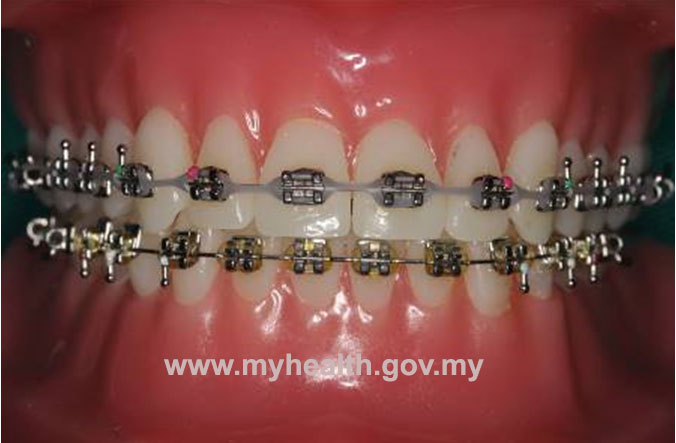
These “chains” are used to help hold the wire in and they also pull the teeth together to close spaces. (These chains are placed by the Orthodontist and not to be removed by the patient until the next orthodontic adjustment appointment).
Who Needs To Wear Elastics?
A typical patient in need of elastics is someone with an excessive overjet. When the overjet exceeds the acceptable measurement (2-4 millimetres) an Orthodontist may decide to utilize rubber bands.
How And When To Wear Them
You should follow directions carefully when wearing elastics for orthodontic treatment. While the addition of rubber bands can cause more pain, discomfort and inconvenience than just having the archwire and ligatures tightened once in a while, following the instruction you are given, will make sure treatment continues on schedule, providing optimal results and you will avoid prolonging the treatment time.
Patients on elastic wear them as full-time or night-time only. Full-time wear is usually prescribed in those situations when tooth and bite movement is desired. Whereas, night-time wear is effective for holding(maintaining) a correction. The difference between full-time and night-time wear is significant, since the teeth and bite will only move if pressure is constant. Therefore, if instructions are not followed, and a patient wears the elastics less than the required duration, the teeth and bite will not move properly. This can slow down the treatment progress and may result in a compromised final result.
You should never double up on the elastics. While this might seem intuitive, it will not save time. The length of time a force is present is more important than the amount of force. In fact, a double application adds so much pressure that it slows down the movement of teeth and can damage their roots.
It is recommended that whenever elastics are taken out, they should be discarded and replaced with new ones. Depending on the strength/thickness of the elastics and what your day-to-day activities are, you might have to replace them 3-4 times every day so you should keep a pack of them on you at all times. It is also advised to change them at least once a day. This is necessary even if they do not break since they tend to lose elasticity and strength over time. Instructions may vary slightly from patient to patient.
The best advice for effective movement is to follow the instructions of the Orthodontist!
Glossary
- Archwire – wire tied into brackets
- Brackets – attachments fixed on teeth forming part of the braces
- Crossbite – arrangement where the lower teeth is too inside or outside the upper teeth
- Elastics – bands made from latex or synthetic material used to exert force on teeth
- Midline – the central position between the right and left side of the dentition
- Overjet – the forward position of the upper front teeth
- Reverse overjet – the forward position of the lower front teeth in front of the upper teeth
References
- Baty DL. Synthetic elastomeric chains: A literature review. American Journal of Orthodontics and Dentofacial Orthopedics 1994; 105(6):536-42
- Singh VP et al. Elastics in orthodontics; A review. Health Renaissance, 2012 ; Vol 10 ( no.1);49-56
| Last Reviewed | : | 28 August 2020 |
| Writer | : | Dr. Lillybia Emily Ebin |
| Accreditor | : | Dr. Arjunan a/l Muthusamy |
| Reviewer | : | Dr. Hjh. Rashidah bt. Dato’ Hj. Burhanudin |


